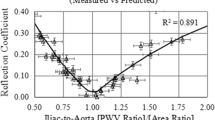Abstract
A frequency domain distributed 55 segment arterial model was constructed from the reflection perspective to predict pressure waveforms in the large systemic arteries. At any node, the predicted pressure waveform was the combination of a forward propagating waveform and a number of repeatedly reflected waveforms from any possible sites. This approach ensured that any single reflected waveform could be traced back to its origin, and thus the causal-effect relation would be precisely known. This model was evaluated in terms of branch reflection coefficient, terminal vascular bed behavior, and wall viscoelasticity. It was found that the model predicted pressure waveforms were most sensitive to the branch reflection coefficient, and this led to the adoption of the zero-forward reflection assumption at branches. The model-predicted pressure waveforms compared favorably with realistic blood pressure waveforms, especially in the upper limbs. For lower limbs, finer segmentation could further improve the predictions.




Similar content being viewed by others
References
Avolio AP. Multi-branched model of the human arterial system. Med Biol Eng Comp. 1980;18:709–18. doi:10.1007/BF02441895.
Bergel DH. Dynamic elastic properties of the arterial wall. J Physiol. 1961;156:458–69.
Berger D, Li JK-J, Laskey WK, Noordergraaf A. Repeated reflection of waves in the systemic arterial system. Am J Physiol Heart & Circ Physiol. 1993;33(264):H269–81.
Gosling RG, Newman DL, Bowden NLR, Twinn KW. The are ratio of normal aortic junctions-aortic configuration and pulse wave reflection. Br J Radiol. 1971;44:850–3.
Guyton AC. Textbook of medical physiology. 5th ed. Philadelphia: Saunders; 1976.
Hardung V. Uber eine Methode zur Messung der dynamischen Elastiziat und Viskositat kautschukahnlicher Korper, insbesondere von Blutgefassen und anderen elastischen Gewebteilen. Helv Physiol Acta. 1952;10:482–98.
Karamanoglu M, Gallagher DE, Avolio AP, O’Rourke MF. Functional origin of reflected pressure waves in a multibranched model of the human arterial system. Am J Physiol. 1995;267:H1363–9.
Karamanoglu M, Gallagher DE, Avolio AP, O’Rourke MF. Pressure wave propagation in a multibranched model of the human upper limb. Am J Physiol. 1994;269:H1681–8.
Li JK-J, Melbin J, Noordergraaf A. Directional disparity of pulse wave reflections in dog arteries. Am J Physiol Heart & Cir Physiol. 1984;247:H95–9.
Li JK-J. Time domain resolution of forward and reflected waves in the aorta. IEEE Trans Biomed Eng. 1986a;BME-33:783–5. doi:10.1109/TBME.1986.325903.
Li JK-J. Dominance of geometric over elastic factors in pulse transmission through arterial branching. Bull Math Biol. 1986b;48:97–103.
Li JK-J. Arterial systems dynamics. New York: New York Univerity Press; 1987.
Li JK-J. Increased arterial pulse wave reflections and pulsatile energy loss in acute hypertension. Angiology J Vasc Dis. 1989;40:730–5.
Li JK-J. The arterial circulation: physical principles and clinical applications. Totowa, NJ: Humana Press; 2000.
Li JK-J. Dynamics of the vascular system. Singapore: World Scientific Publishers; 2004.
Li JK-J, Zhu Y, O’Hara D, Khaw K. Allometric hemodynamic analysis of isolated systolic hypertension and aging. Cardiovasc Eng. 2007;7:135–9. doi:10.1007/s10558-007-9040-x.
McDonald DA. Blood flow in arteries. 2nd ed. London: Edward Arnold Ltd; 1974.
O’Rourke MF. Arterial hemodynamics in hypertension. Circ Res. 1970;27(2):123–33.
Papageorgiou GL, Jones NB, Redding VJ, Hudson N. The area ratio of normal arterial junctions and its implications in pulse wave reflections. Cardiovasc Res. 1990;6:478–84. doi:10.1093/cvr/24.6.478.
Noordergraaf A, Jager GN, Westerhof N, editors. Circulatory analog computers, Proc. of symposium on development of analog computers in the study of mammalian circulatory systems. Amsterdam: North-Holland Publishing; 1963.
Noordergraaf A. Hemodynamics. In: Schwann HP, editor. Biological Engineering. New York: McGraw-Hill; 1969.
Safar ME, Simon AC, Levenson JA. Structural changes of large arteries in sustained essential hypertension. Hypertension. 1984;6(3):117–21.
Schaaf BW, Abbrecht PH. Digital computer simulation of human systemic arterial pulse transmission: a non-linear model. J Biomech. 1972;5:345–64.
Segers P, Stergiopulos N, Verdonck P, Verhoeven R. Assessment of distributed arterial network models. Med Biol Eng Comput. 1997;35:729–36.
Snyder MF, Rideout VC, Hillestead RJ. Computer modeling of the human systemic arterial tree. J Biomech. 1968;1:341–53.
Stergiopulos N. Computer simulation of arterial blood flow. Ph.D. Dissertation. Iowa State University, Ames; 1990.
Stergiopulos N, Young DF, Rogge TR. Computer simulation of arterial flow with applications to arterial and aortic stenoses. J Biomech. 1992;25(12):1477–88.
Taylor MG. Wave transmission through an assembly of randomly branching elastic tubes. Biophys J. 1966;6(6):697–716.
Wang JJ. Wave Propagation in a model of the human arterial system. Ph.D. Dissertation. University of London, London; 1997.
Wang JJ, Parker KH. Wave propagation in a model of the arterial circulation. Biomechanics. 2004;37:457–70.
Westerhof N, Bosman F, DeVries CJ, Noordergraaf A. Analog studies of the human systemic arterial tree. J Biomech. 1969;2:121–43.
Womersley JR. Oscillatory flow in arteries: the constrained elastic tube as a model of arterial flow and pulse transmission. Phys Med Biol. 1957;2(2):178–87.
Zhang H. A novel frequency domain arterial tree model: distributed wave reflections and potential clinical applications. Ph.D. Dissertation. Rutgers, the State University of New Jersey; 2006.
Author information
Authors and Affiliations
Corresponding author
Rights and permissions
About this article
Cite this article
Zhang, H., Li, J.KJ. A Novel Wave Reflection Model of the Human Arterial System. Cardiovasc Eng 9, 39–48 (2009). https://doi.org/10.1007/s10558-009-9074-3
Received:
Accepted:
Published:
Issue Date:
DOI: https://doi.org/10.1007/s10558-009-9074-3




